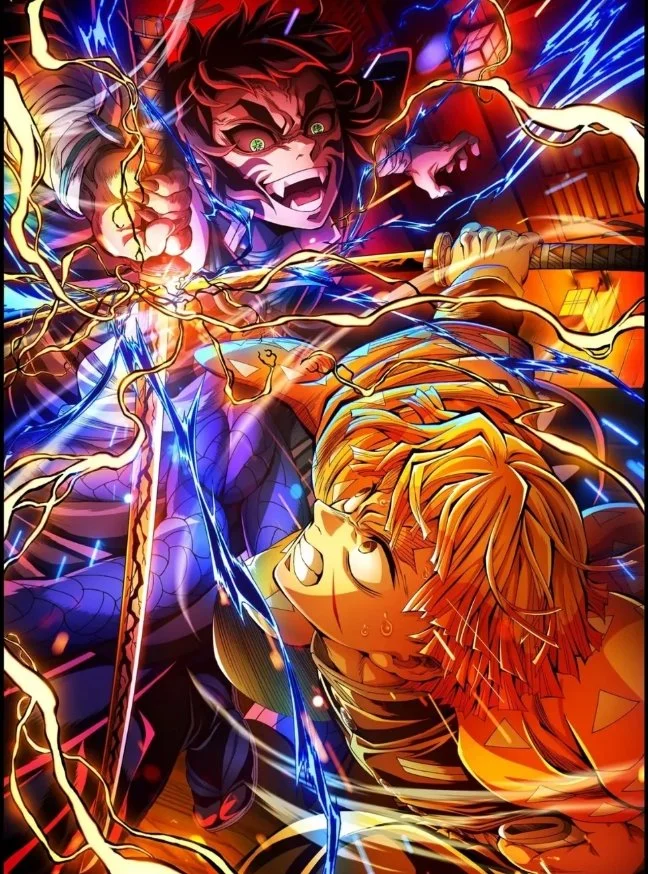‘Demon Slayer’ spends seeming eternity at top of box office mountain
photo from the Official Demon Slayer Instagram page
As the modern world becomes more globalized, international films are rapidly becoming popular among both average American audiences and critics alike. Cinematic culture is dramatically shifting as countries like China, Japan, France, and India continue to produce movies that shatter their country’s personal records, but also some American records as well. Recently, one movie has been sending shockwaves through international and American theaters. Kimetsu No Yaiba (Demon Slayer): Infinity Castle, directed by Haruo Sotozaki, has shattered box office records by grossing over 555 million dollars worldwide, making it the highest-grossing anime and Japanese film of all time. Unlike other anime films, Infinity Castle mixes emotion and action into one jam packed film. The film incorporates choreographed fight scenes and drawn out, heart-breaking moments. Infinity Castle encapsulates the talent and ingenuity of international production and of Sotozaki’s work.
The action-packed anime begins shortly after Kagaya Ubuyashiki (voiced by Mathew Mercer, Monsters University) self-destructs his body while stalling out the main villain of the anime, Muzan Kibutsuji (Greg Chun, The Nut Job 2), the rageful and cunning demon king. However, in classic anime fashion, Muzan barely survives the blast. As the flames of the explosion engulf his shattered body, Muzan telepathically teleports every demon slayer into the Infinity Castle, a never ending dimension of rooms and temples that span beyond what the eye can see.
The main cast of heroes are flung into the infinite world one by one to fend for themselves against hordes of blood-thirsty demons, all under Muzan’s control, waiting to sink their teeth upon the hundreds of Demon Slayers presented before them. One of the main cast of heroes is Zenitsu (voiced by Aleks Le, Ne Zha), who perfectly embodies an anxious and cowardly slayer, which is a contrast to the average calm and calculated slayer. After wandering the never ending sequence of rooms, Zenitsu stumbles upon his adopted older brother, Kaigaku (Alejandro Saab, Row 19). Zenitsu angrily lashes out at Kaigaku for becoming a demon, blaming him for the death of their teacher, and bringing disrespect to thunder breathing–a style of swordsmanship in the world of Demon Slayer–to which Kaigaku degrades Zenitsu, calling him weak, useless, an embarrassment, and overall unfit to be called Kaigaku’s brother. Sotozaki craftily darkens Zenitsu’s entire personality to how he responds, how he thinks, and even to how he stands upon hearing those words. During this beautifully animated fight between two different brothers, their journeys to becoming the strongest form of themselves are portrayed through their calculated attacks and difference in fighting style. Eventually, after pushing far beyond the limit of his swordsmanship, Zenitsu defeats Kaigaku, symbolizing Zenitsu’s mastery in thunder breathing, and triumph over his past cowardice, and the cowardice of his brother’s betrayal of their master.
On the opposite side of the Infinity Castle, the strong-willed main character, Tanjiro Kamado (Zach Aguilar, Cyberpunk: Edgerunners) savagely searches for the injured Muzan, not wanting to give Muzan time to regenerate. While he’s searching, one of Muzan’s strongest demons, Akaza (Lucien Dodge, Logan) ambushes Tanjiro, sending him flying through the expanse of never ending rooms. After being assisted by his comrade Giyu Tomioka (Johnny Yong, Time to Hunt) Tanjiro and Giyu fight back against Akaza, once again symbolizing an one of the many underlining themes of brotherhood Sotozaki specializes in. Towards the end of the fight, in traditional anime style Tanjiro unlocks a flashback into his childhood. Sotozaki uses Tanjiro’s father (Kirk Thornton, Spycies) to explain the importance of selflessness, but also the need to fight with no emotion, entering a world in which the fighter is completely unpredictable and undetectable. After Tanjiro awakens this emotionless sense, he is able to defeat Akaza. Although in a turn of events, Sotozaki completely surprises the viewers and reveals that an unknown will to fight allowed him to regenerate his head, completely shattering Tanjiro’s moment. Sotozaki dives deep into Akaza’s backstory and reveals Akaza’s depressing life as a human, showing Akaza losing his father to suicide, then getting adopted, falling in love with his master’s sickly daughter, and eventually losing them. Sotozaki pulls the string of every viewer in the theater, directing the most emotional scene in the whole franchise, by bringing Akaza’s lover in the form of a ghost making him remember every person he had killed. The scene ends intensely, with Akaza’s lover trading her life in heaven to be with him in hell, showing Sotozaki’s masterclass ability to create an amazing story about multiple themes. This allows viewers to connect with the characters on an emotional level which no other director can do with such skill, while still being able to include perfectly choreographed fights and action to keep it interesting.
Overall Demon Slayer: Infinity Castle raises the bar for all animated movies internationally. Demon Slayer makes fans connect with characters on a deeper level and utilizes a unique art style that compliments Sotozaki’s advanced fighting choreography, keeping viewers on their toes by wondering what will happen next.
Grade: A+
Sotozaki’s Demon Slayer: Infinity Castle redefines the definition of an anime movie by creating fight scenes that dwarf other genre entries whilst maintaining narrative poetry and panache.
by Logan Auxier
Published October 6, 2025
Oshkosh West Index Volume 122 Issue I
